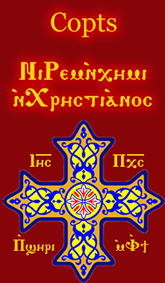Coptic art
|
Coptic art is a term used either for the art of Egypt produced in the early Christian era or for the art produced by the Coptic Christians themselves. Coptic art is most well known for its wall-paintings, textiles, illuminated manuscripts, and metalwork, much of which survives in monasteries and churches. The artwork is often functional, as little distinction was drawn between artistry and craftsmanship, and includes tunics and tombstones as well as portraits of saints. The Coptic Museum in Coptic Cairo houses some of the world's most important examples of Coptic art.
Coptic art displays a mix of native Egyptian and Hellenistic influences. Subjects and symbols were taken from both Greek and Egyptian mythology, sometimes altered to fit Christian beliefs. Persia and Syria also influenced Coptic art, though to a lesser extent, leaving images such as the peacock and the griffin.
Coptic icons have their origin in the Hellenistic art of Egyptian Late Antiquity, as exemplified by the Fayum mummy portraits. The faces of El Fayum are examples of the Coptic art in the 2nd century AD showing the Greek and Roman influence on the Coptic art but with some distinctive features related to Egyptian art.
The Arabic conquest of Egypt allowed the Coptic art to influence the Islamic art and architecture with many features that are now integral in the Islamic art.
Beginning in the 4th century, churches painted their walls and made icons to reflect an authentic expression of their faith.
The figures of saints display eyes and ears larger in proportion to the rest of the face and a smaller mouth, as well as enlarged heads, signifying a spiritual relationship with God and devotion to prayer. Martyrs' faces were peaceful.
Many Coptic icon painters did not sign their names, but the prominent among them include St. Luke (traditionally believed to be the first icon painter) and two Coptic Popes, Pope Macarius I and Pope Gabriel III
Starting mid-18th century icon painting enjoyed a revival in Egypt and once again was popular. One of the most famous artists was Yuhanna al-Armani whose works were noted for using more developed techniques and novel construction (e.g. using a set of icons to tell a single story).
...
Wikipedia

